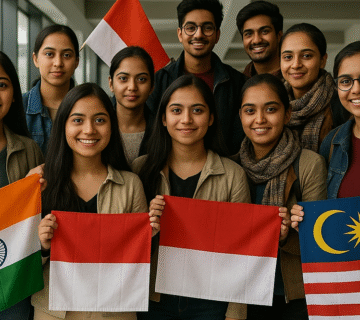Every year, thousands of Indian students head abroad to pursue international degrees, global exposure, and promising career opportunities. Traditionally, English-speaking countries like the U.S., UK, Canada, and Australia have topped the list of preferred destinations. However, rising tuition fees, intense competition, and visa uncertainties in these countries are prompting a shift in perspective.
It’s time to think beyond the usual. Non-English-speaking countries such as France, Spain, Italy, Mexico, Malaysia, Vietnam, and Hungary are becoming increasingly attractive for Indian students — not just for their affordability, but for the well-rounded, enriching experiences they offer.
1. Affordable Education and Lower Living Costs
One of the most compelling reasons to consider non-English-speaking countries is cost. Many public universities in countries like France, Italy, and Hungary offer top-tier education at a fraction of the cost compared to their English-speaking counterparts. Additionally, living expenses in cities such as Budapest, Kuala Lumpur, or Valencia are significantly lower, making higher education abroad more accessible and sustainable.
Government scholarships and financial aid for international students are often more readily available too, further reducing the financial burden.
2. Opportunity to Learn a New Language
Studying in a non-English-speaking country presents a unique chance to become multilingual — a skill that’s highly valued in today’s interconnected world. Whether it’s French, Spanish, Italian, Hungarian, or Vietnamese, gaining proficiency in a new language enhances your CV and opens up career opportunities across diverse regions.
Plus, many universities in these countries now offer English-taught programs, allowing students to pursue their studies while gradually immersing themselves in the local language and culture.
3. Cultural Immersion and Personal Growth
Education abroad isn’t just about academics. It’s about personal transformation. Countries like Spain, Italy, and Mexico are steeped in rich history, art, and tradition, while Malaysia and Vietnam provide vibrant, fast-evolving cultural landscapes.
From savoring French pastries and dancing at Spanish fiestas to navigating bustling Vietnamese markets or exploring ancient Mexican heritage sites — the experience is deeply immersive. Living outside one’s comfort zone helps develop resilience, adaptability, and a truly global outlook.
4. A Gateway to Europe or Asia
Many of these countries offer strategic geographic advantages. Nations like Hungary and France are part of the Schengen Area, allowing easy access to travel, internships, and job markets across Europe. Similarly, Malaysia acts as a hub to the booming economies of Southeast Asia, making it a smart base for students looking to tap into regional opportunities.
This mobility greatly enhances students’ chances of finding internships and job placements beyond the country they study in.
5. Warm Welcome and Growing Indian Communities
Non-English-speaking countries are increasingly courting Indian students and building robust support systems. With active Indian student associations, cultural festivals, and local communities, students find it easier to stay connected with their roots while embracing a new way of life.
This welcoming atmosphere helps ease the transition, especially for first-time international students.
In Conclusion: Step Outside the Usual. Step Into the Exceptional.
The global education landscape is evolving — and so should our choices. While traditional destinations still hold value, non-English-speaking countries now offer a compelling mix of affordability, culture, opportunity, and personal growth.
For Indian students dreaming of a global career, it might be time to explore the road less traveled. You might just find it leads somewhere extraordinary.
Ready to explore your options?
Let us help you find the right destination that matches your dreams — academically, culturally, and financially.



No comment